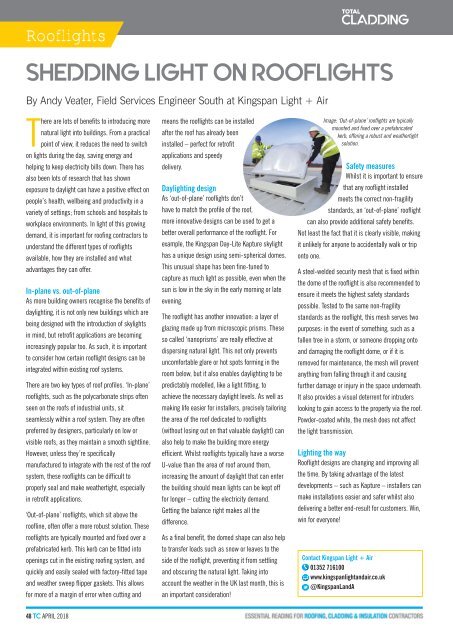April 2018
Create successful ePaper yourself
Turn your PDF publications into a flip-book with our unique Google optimized e-Paper software.
Rooflights<br />
SHEDDING LIGHT ON ROOFLIGHTS<br />
By Andy Veater, Field Services Engineer South at Kingspan Light + Air<br />
There are lots of benefits to introducing more<br />
natural light into buildings. From a practical<br />
point of view, it reduces the need to switch<br />
on lights during the day, saving energy and<br />
helping to keep electricity bills down. There has<br />
also been lots of research that has shown<br />
exposure to daylight can have a positive effect on<br />
people’s health, wellbeing and productivity in a<br />
variety of settings; from schools and hospitals to<br />
workplace environments. In light of this growing<br />
demand, it is important for roofing contractors to<br />
understand the different types of rooflights<br />
available, how they are installed and what<br />
advantages they can offer.<br />
In-plane vs. out-of-plane<br />
As more building owners recognise the benefits of<br />
daylighting, it is not only new buildings which are<br />
being designed with the introduction of skylights<br />
in mind, but retrofit applications are becoming<br />
increasingly popular too. As such, it is important<br />
to consider how certain rooflight designs can be<br />
integrated within existing roof systems.<br />
There are two key types of roof profiles. ‘In-plane’<br />
rooflights, such as the polycarbonate strips often<br />
seen on the roofs of industrial units, sit<br />
seamlessly within a roof system. They are often<br />
preferred by designers, particularly on low or<br />
visible roofs, as they maintain a smooth sightline.<br />
However, unless they’re specifically<br />
manufactured to integrate with the rest of the roof<br />
system, these rooflights can be difficult to<br />
properly seal and make weathertight, especially<br />
in retrofit applications.<br />
‘Out-of-plane’ rooflights, which sit above the<br />
roofline, often offer a more robust solution. These<br />
rooflights are typically mounted and fixed over a<br />
prefabricated kerb. This kerb can be fitted into<br />
openings cut in the existing roofing system, and<br />
quickly and easily sealed with factory-fitted tape<br />
and weather sweep flipper gaskets. This allows<br />
for more of a margin of error when cutting and<br />
means the rooflights can be installed<br />
after the roof has already been<br />
installed – perfect for retrofit<br />
applications and speedy<br />
delivery.<br />
Daylighting design<br />
As ‘out-of-plane’ rooflights don’t<br />
have to match the profile of the roof,<br />
more innovative designs can be used to get a<br />
better overall performance of the rooflight. For<br />
example, the Kingspan Day-Lite Kapture skylight<br />
has a unique design using semi-spherical domes.<br />
This unusual shape has been fine-tuned to<br />
capture as much light as possible, even when the<br />
sun is low in the sky in the early morning or late<br />
evening.<br />
The rooflight has another innovation: a layer of<br />
glazing made up from microscopic prisms. These<br />
so called ‘nanoprisms’ are really effective at<br />
dispersing natural light. This not only prevents<br />
uncomfortable glare or hot spots forming in the<br />
room below, but it also enables daylighting to be<br />
predictably modelled, like a light fitting, to<br />
achieve the necessary daylight levels. As well as<br />
making life easier for installers, precisely tailoring<br />
the area of the roof dedicated to rooflights<br />
(without losing out on that valuable daylight) can<br />
also help to make the building more energy<br />
efficient. Whilst rooflights typically have a worse<br />
U-value than the area of roof around them,<br />
increasing the amount of daylight that can enter<br />
the building should mean lights can be kept off<br />
for longer – cutting the electricity demand.<br />
Getting the balance right makes all the<br />
difference.<br />
As a final benefit, the domed shape can also help<br />
to transfer loads such as snow or leaves to the<br />
side of the rooflight, preventing it from settling<br />
and obscuring the natural light. Taking into<br />
account the weather in the UK last month, this is<br />
an important consideration!<br />
Image: ‘Out-of-plane’ rooflights are typically<br />
mounted and fixed over a prefabricated<br />
kerb, offering a robust and weathertight<br />
solution.<br />
Safety measures<br />
Whilst it is important to ensure<br />
that any rooflight installed<br />
meets the correct non-fragility<br />
standards, an ‘out-of-plane’ rooflight<br />
can also provide additional safety benefits.<br />
Not least the fact that it is clearly visible, making<br />
it unlikely for anyone to accidentally walk or trip<br />
onto one.<br />
A steel-welded security mesh that is fixed within<br />
the dome of the rooflight is also recommended to<br />
ensure it meets the highest safety standards<br />
possible. Tested to the same non-fragility<br />
standards as the rooflight, this mesh serves two<br />
purposes: in the event of something, such as a<br />
fallen tree in a storm, or someone dropping onto<br />
and damaging the rooflight dome, or if it is<br />
removed for maintenance, the mesh will prevent<br />
anything from falling through it and causing<br />
further damage or injury in the space underneath.<br />
It also provides a visual deterrent for intruders<br />
looking to gain access to the property via the roof.<br />
Powder-coated white, the mesh does not affect<br />
the light transmission.<br />
Lighting the way<br />
Rooflight designs are changing and improving all<br />
the time. By taking advantage of the latest<br />
developments – such as Kapture – installers can<br />
make installations easier and safer whilst also<br />
delivering a better end-result for customers. Win,<br />
win for everyone!<br />
Contact Kingspan Light + Air<br />
01352 716100<br />
www.kingspanlightandair.co.uk<br />
@KingspanLandA<br />
48 TC APRIL <strong>2018</strong>

















